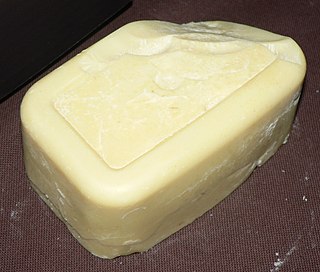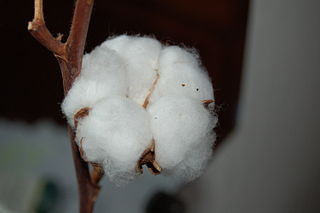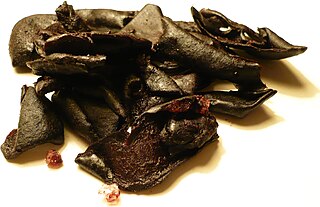Composition and characteristics of oil / fat


Mango kernel oil is solid at room temperature with a melting point of (35–43 °C, 95–109 °F).
Physical characteristics of mango kernel oil [5]
| Fatty acids present in mango fat [6]
|
| Saturated fats | |
|---|---|
| Total saturated | 45-50 |
| Unsaturated fats | |
| Total unsaturated | 50-55 |
| Monounsaturated | 40-46 |
| Omega-6 fatty acids | 3-4 |
| Properties | |
| Melting point | 32–43 °C (90–109 °F) |
| Solidity at 20 °C (68 °F) | semi-solid |
| Iodine value | 32.0-60.7 |
Mango oil, mango kernel fat, [1] or mango butter, is an oil fraction obtained during the processing of mango butter. Mango oil is a seed oil extracted from the stone of the mango, the fruit of the Mangifera indica tree. The oil is semi-solid at room temperatures, but melts on contact with warm skin, making it appealing for baby creams, suncare balms, hair products, and other moisturizing products. The oil is a soft yellow color with a melting point of 32–42 °C (90–108 °F).
Fat is extracted from dried mango kernels by hydraulic pressure, [2] or by solvent extraction. [3] In solvent extraction, hexane, a liquid hydrocarbon, is used as the extraction medium. The collected mango stones are washed with well-water soon after collection. After washing, the seeds are sun-dried to reduce the moisture content to 12-15%. The dried seed stone is roasted in a drum roaster and the hull is removed mechanically, or manually by beating with wooden clubs. The separated kernels are crushed into small pieces in a hammer mill. The mango kernel pieces are conveyed to a pellet making machine and pellets are formed. The pellets are cooled to room temperature in a cooler and are conveyed to the solvent extraction plant. Some processors produce flakes by crushing the seeds in a flaking roller mill. [4]


Mango kernel oil is solid at room temperature with a melting point of (35–43 °C, 95–109 °F).
Physical characteristics of mango kernel oil [5]
| Fatty acids present in mango fat [6]
|

Chocolate or cocoa is a food made from roasted and ground cacao seed kernels that is available as a liquid, solid, or paste, either on its own or as a flavoring agent in other foods. Cacao has been consumed in some form since at least the Olmec civilization, and later Mesoamerican civilizations also consumed chocolate beverages before being introduced to Europe in the 16th century.

Nutella is a brand of brown, sweetened hazelnut cocoa spread. Nutella is manufactured by the Italian company Ferrero and was introduced in 1964, although its first iteration dates to 1963.

Vegetable oils, or vegetable fats, are oils extracted from seeds or from other parts of fruits. Like animal fats, vegetable fats are mixtures of triglycerides. Soybean oil, grape seed oil, and cocoa butter are examples of seed oils, or fats from seeds. Olive oil, palm oil, and rice bran oil are examples of fats from other parts of fruits. In common usage, vegetable oil may refer exclusively to vegetable fats which are liquid at room temperature. Vegetable oils are usually edible.

Cocoa butter, also called theobroma oil, is a pale-yellow, edible fat extracted from the cocoa bean. It is used to make chocolate, as well as some ointments, toiletries, and pharmaceuticals. Cocoa butter has a cocoa flavor and aroma. Its melting point is slightly below human body temperature. It is an essential ingredient of chocolate and related confectionary products.

Shea butter is a fat extracted from the nut of the African shea tree. It is ivory in color when raw and commonly dyed yellow with borututu root or palm oil. It is widely used in cosmetics as a moisturizer, salve or lotion. Shea butter is edible and is used in food preparation in some African countries. Occasionally, shea butter is mixed with other oils as a substitute for cocoa butter, although the taste is noticeably different.

White chocolate is a confectionery typically made of sugar, milk, and cocoa butter, but no cocoa solids. It is pale ivory in color, and lacks many of the compounds found in milk, dark, and other chocolates. It is solid at room temperature because the melting point of cocoa butter, the only white cocoa bean component, is 35 °C (95 °F).

Cottonseed is the seed of the cotton plant.

Compound chocolate is a product made from a combination of cocoa, vegetable fat and sweeteners. It is used as a lower-cost alternative to pure chocolate, as it uses less-expensive hard vegetable fats such as coconut oil or palm kernel oil in place of the more expensive cocoa butter. It may also be known as "compound coating" or "chocolatey coating" when used as a coating for candy. It is often used in less expensive chocolate bars to replace enrobed chocolate on a product.

Fragrance extraction refers to the separation process of aromatic compounds from raw materials, using methods such as distillation, solvent extraction, expression, sieving, or enfleurage. The results of the extracts are either essential oils, absolutes, concretes, or butters, depending on the amount of waxes in the extracted product.

Plant oils or vegetable oils are oils derived from plant sources, as opposed to animal fats or petroleum. There are three primary types of plant oil, differing both the means of extracting the relevant parts of the plant, and in the nature of the resulting oil:

Chocolate is a food product made from roasted and ground cocoa pods mixed with fat and powdered sugar to produce a solid confectionery. There are several types of chocolate, classified primarily according to the proportion of cocoa and fat content used in a particular formulation.

Astrocaryum murumuru is a palm native to Amazon Rainforest vegetation in Brazil, which bears edible fruits. Murumuru butter, extracted from the seeds of the plant, may be used as a moisturizer. One remarkable feature of this palm is that it is covered with spines up to twelve inches in length.

Dry cocoa solids are the components of cocoa beans remaining after cocoa butter, the fatty component of the bean, is extracted from chocolate liquor, roasted cocoa beans that have been ground into a liquid state. Cocoa butter is 46% to 57% of the weight of cocoa beans and gives chocolate its characteristic melting properties. Cocoa powder is the powdered form of the dry solids with a small remaining amount of cocoa butter. Untreated cocoa powder is bitter and acidic. Dutch process cocoa has been treated with an alkali to neutralize the acid.

Chocolate bloom is either of two types of whitish coating that can appear on the surface of chocolate: fat bloom, caused by changes in the fat crystals in the chocolate; and sugar bloom, due to crystals formed by the action of moisture on the sugar. Fat and sugar bloom damage the appearance of chocolate but do not limit its shelf life. Chocolate that has "bloomed" is still safe to eat, but may have an unappetizing appearance and surface texture. Chocolate bloom can be repaired by melting the chocolate down, stirring it, then pouring it into a mould and allowing it to cool, bringing the sugar or fat back into the solution.
The following outline is provided as an overview of and topical guide to chocolate:

An oil mill is a grinding mill designed to crush or bruise oil-bearing seeds, such as linseed or peanuts, or other oil-rich vegetable material, such as olives or the fruit of the oil palm, which can then be pressed to extract vegetable oils, which may be used as foods or for cooking, as oleochemical feedstocks, as lubricants, or as biofuels. The pomace or press cake – the remaining solid material from which the oil has been extracted – may also be used as a food or fertilizer.
Vateria indica oil is extracted from the seeds of the Vateria indica plant, a species in the family Dipterocarpaceae. The Vateria indica plant is indigenous to the Western Ghats, Kerala and Tamil Nadu regions of India. It thrives in the evergreen forests, surviving up to 800 meters above sea level. Oil from the seeds of the plant is extracted through a chemical refining process which makes the plant edible.

Shorea robusta seed oil is an edible oil extracted from the seeds of Shorea robusta. Shorea robusta is known as the Sal tree in India. Sal is indigenous to India and occurs in two main regions separated by the Gangetic Plain, namely the northern and central Indian regions. The plant belongs to the Dipterocarpaceae botanical family.

Kokum oil is a seed oil derived from the seeds of the kokum tree. Kokum oil is edible and can also be used for things other than cooking.

Corn wet-milling is a process of breaking corn kernels into their component parts: corn oil, protein, corn starch, and fiber. It uses water and a series of steps to separate the parts to be used for various products.